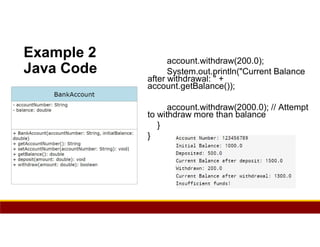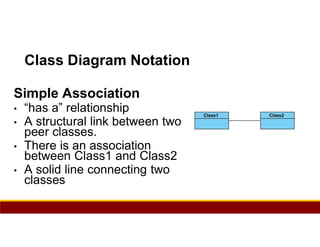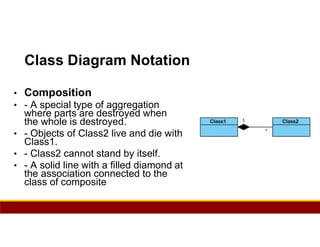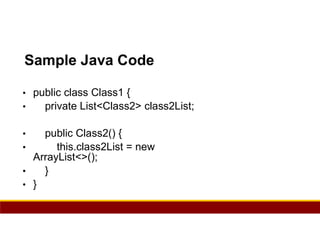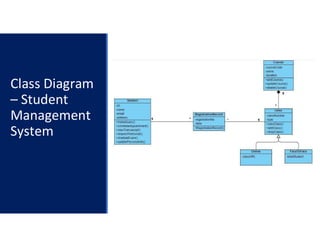Introduction to Java Object Oriented Programming
- 2. 2 Which of the following is NOT a principle of Object-Oriented Programming? A) Encapsulation B) Abstraction C) Inheritance D) Multithreading
- 3. 3 Answer and Explanation D) Multithreading Multithreading is a concept related to concurrent programming, not strictly a principle of OOP.
- 4. 4 In Java, which keyword is used to implement inheritance between classes? A) this B) extends C) implements D) inherit
- 5. 5 Answer and Explanation B) extends The keyword "extends" is used to establish an inheritance relationship between classes in Java.
- 6. 6 Which OOP concept describes the ability of an object to take many forms? A) Polymorphism B) Abstraction C) Inheritance D) Encapsulation
- 7. 7 Answer and Explanation A) Polymorphism Polymorphism allows objects to be treated as instances of their parent class, enabling flexibility in programming.
- 8. 8 Which access modifier allows a variable or method to be accessible only within its own class? A) public B) private C) protected D) default (no modifier)
- 9. 9 Answer and Explanation B) private Private access modifier restricts access to members within the same class only.
- 10. 10 Which access modifier allows a variable or method to be accessible only within its own class? A) public B) private C) protected D) default (no modifier)
- 11. 11 Answer and Explanation B) private Private access modifier restricts access to members within the same class only.
- 12. 12 Which OOP concept refers to bundling data and methods that operate on the data into a single unit? A) Encapsulation B) Inheritance C) Polymorphism D) Abstraction
- 13. 13 Answer and Explanation A) Encapsulation Encapsulation hides the internal state of an object and restricts access to it.
- 14. 14 Which method is automatically called when an object is created in Java? A) init() B) start() C) main() D) constructor()
- 15. 15 Answer and Explanation D) constructor() Constructors initialize objects when they are created.
- 16. 16 Which OOP concept allows a class to have multiple methods with the same name but different parameters? A) Overriding B) Overloading C) Polymorphism D) Encapsulation
- 17. 17 Answer and Explanation B) Overloading Overloading enables a class to have multiple methods with the same name but different parameter lists.
- 18. 18 Which keyword is used to refer to the current instance of a class in Java? A) that B) self C) this D) here
- 19. 19 Answer and Explanation C) this The "this" keyword refers to the current instance of the class.
- 20. 20 Which OOP principle describes the process of hiding the implementation details of an object? A) Inheritance B) Encapsulation C) Polymorphism D) Abstraction
- 21. 21 Answer and Explanation D) Abstraction Abstraction focuses on hiding the internal implementation details of objects and showing only the necessary features.
- 22. 22 Which keyword is used to indicate that a method does not return any value in Java? A) void B) null C) none D) empty
- 23. 23 Answer and Explanation A) void The "void" keyword is used in method declarations to indicate that the method does not return any value.
- 24. 24 Which OOP concept allows a class to inherit attributes and methods from another class? A) Encapsulation B) Polymorphism C) Inheritance D) Abstraction
- 25. 25 Answer and Explanation C) Inheritance Inheritance enables the creation of a new class that adopts the properties and behaviors of an existing class.
- 26. 26 Which OOP principle describes the ability of objects to share behaviors or characteristics with other objects? A) Inheritance B) Encapsulation C) Polymorphism D) Abstraction
- 27. 27 Answer and Explanation A) Inheritance Inheritance allows objects to acquire properties and behaviors from parent objects, facilitating code reuse and organization.
- 28. 28 Which OOP principle describes the ability of objects to share behaviors or characteristics with other objects? A) Inheritance B) Encapsulation C) Polymorphism D) Abstraction
- 29. 29 Answer and Explanation A) Inheritance Inheritance allows objects to acquire properties and behaviors from parent objects, facilitating code reuse and organization.
- 30. 30 What is the process of defining a new class based on an existing class, thereby inheriting its attributes and methods? A) Composition B) Polymorphism C) Inheritance D) Encapsulation
- 31. 31 Answer and Explanation C) Inheritance Inheritance allows for the creation of new classes that acquire properties and behaviors from existing classes.
- 32. 32 Which OOP concept allows a class to have multiple methods with the same name and parameter list, but different functionality? A) Inheritance B) Encapsulation C) Polymorphism D) Abstraction
- 33. 33 Answer and Explanation C) Polymorphism Polymorphism allows methods to be overridden in subclasses, providing different implementations while using the same method signature.
- 34. 34 What does the term "method overloading" refer to in Java? A) Defining a method with the same name in different classes B) Defining multiple methods with the same name but different parameter lists in the same class C) Calling a method from within another method D) Overriding a method in a subclass
- 35. 35 Answer and Explanation B) Defining multiple methods with the same name but different parameter lists in the same class Method overloading allows a class to have multiple methods with the same name but different parameter lists.
- 36. 36 Which OOP concept allows a class to hide the implementation details of its methods while still providing access to their functionality? A) Inheritance B) Polymorphism C) Abstraction D) Encapsulation
- 37. 37 Answer and Explanation C) Abstraction Abstraction focuses on hiding the implementation details of methods and showing only the essential features.
- 38. 38 Which access modifier provides the widest accessibility in Java, allowing a variable or method to be accessed from anywhere? A) public B) private C) protected D) default (no modifier)
- 39. 39 Answer and Explanation A) public The "public" access modifier allows a variable or method to be accessed from any class.
- 40. 40 What is the purpose of the "this" keyword in Java? A) It refers to the current instance of the class. B) It references the superclass. C) It indicates that a method does not return any value. D) It is used to prevent a class from being inherited.
- 41. 41 Answer and Explanation A) It refers to the current instance of the class. The "this" keyword is used to refer to the current instance of the class.
- 42. 42 In Java, what does the term "encapsulation" refer to? A) It refers to the process of hiding the implementation details of a class. B) It allows a class to inherit attributes and methods from another class. C) It describes the ability of objects to share behaviors or characteristics with other objects. D) It involves bundling data and methods that operate on the data into a single unit.
- 43. 43 Answer and Explanation D) It involves bundling data and methods that operate on the data into a single unit. Encapsulation hides the internal state of an object and restricts access to it, while bundling data and methods together.
- 44. 44 Which OOP concept allows a class to provide different implementations of methods that are called by the same name? A) Inheritance B) Encapsulation C) Polymorphism D) Abstraction
- 45. 45 Answer and Explanation C) Polymorphism Polymorphism allows for the implementation of methods to vary depending on the object that invokes them.
- 46. 46 What is the purpose of the "extends" keyword in Java? A) It is used to prevent a class from being inherited. B) It is used to establish an inheritance relationship between classes. C) It allows a class to provide multiple implementations of a method. D) It is used to declare a method that does not return any value.
- 47. 47 Answer and Explanation B) It is used to establish an inheritance relationship between classes. The "extends" keyword is used to create a subclass that inherits properties and behaviors from a superclass.
- 48. 48 Which keyword is used to create an object of a class in Java? A) new B) class C) object D) instance
- 49. 49 Answer and Explanation A) new The "new" keyword is used to instantiate an object of a class in Java.
- 50. 50 In Java, what is the purpose of the "default" access modifier? A) It allows access to the variable or method only within the same package. B) It restricts access to the variable or method to only subclasses. C) It makes the variable or method accessible from anywhere in the program. D) It hides the variable or method from being accessed outside the class.
- 51. 51 Answer and Explanation A) It allows access to the variable or method only within the same package. The "default" access modifier allows access within the same package but not outside of it.
- 52. 52 Which OOP concept allows a class to implement multiple interfaces in Java? A) Inheritance B) Encapsulation C) Polymorphism D) Interface
- 53. 53 Answer and Explanation D) Interface Interfaces in Java allow a class to implement multiple behaviors, enabling polymorphism.
- 54. 54 What is the term for the process of hiding the internal state of an object and requiring all interactions to occur through well-defined interfaces? A) Abstraction B) Polymorphism C) Inheritance D) Overriding
- 55. 55 Answer and Explanation A) Abstraction Abstraction involves hiding internal details and exposing only necessary features through well- defined interfaces.
- 56. 56 In Java, what is the purpose of the "implements" keyword? A) It is used to establish an inheritance relationship between classes. B) It allows a class to define multiple implementations of a method. C) It is used to indicate that a class is a subclass of another class. D) It is used to declare that a class implements an interface.
- 57. 57 Answer and Explanation D) It is used to declare that a class implements an interface. The "implements" keyword is used to indicate that a class implements one or more interfaces.
- 58. 58 Which OOP concept allows different classes to share some common functionality or behavior? A) Inheritance B) Encapsulation C) Polymorphism D) Abstraction
- 59. 59 Answer and Explanation A) Inheritance Inheritance allows classes to share properties and behaviors from a common superclass.
- 60. 60 What is the term for the process of defining a new class based on an existing class, thereby inheriting its attributes and methods? A) Composition B) Polymorphism C) Inheritance D) Encapsulation
- 61. 61 Answer and Explanation C) Inheritance Inheritance allows for the creation of new classes that acquire properties and behaviors from existing classes.
- 62. 62 What is the term for the process of defining a new class based on an existing class, thereby inheriting its attributes and methods? A) Composition B) Polymorphism C) Inheritance D) Encapsulation
- 63. 63 Answer and Explanation C) Inheritance Inheritance allows for the creation of new classes that acquire properties and behaviors from existing classes.
- 64. 64 Which OOP concept allows a class to provide different implementations of methods based on their parameter types? A) Inheritance B) Encapsulation C) Polymorphism D) Abstraction
- 65. 65 Answer and Explanation C) Polymorphism Polymorphism in Java allows methods to be invoked with different arguments, resulting in different behavior.
- 66. 66 Which access modifier restricts access to the variable or method to only subclasses and classes within the same package? A) private B) public C) protected D) default (no modifier)
- 67. 67 Answer and Explanation C) protected The "protected" access modifier allows access to subclasses and classes within the same package, but not from other packages.
- 68. 68 What is the purpose of the "abstract" keyword in Java? A) It is used to create abstract classes. B) It is used to prevent a class from being instantiated. C) It indicates that a method must be overridden in subclasses. D) It allows a class to define multiple implementations of a method.
- 69. 69 Answer and Explanation A) It is used to create abstract classes. The "abstract" keyword is used to declare abstract classes and methods in Java.
- 70. 70 Which OOP concept describes the ability of objects to share behaviors or characteristics with other objects through a common interface? A) Inheritance B) Encapsulation C) Polymorphism D) Abstraction
- 71. 71 Answer and Explanation A) Inheritance Inheritance allows objects to share properties and behaviors through a common superclass.
- 72. 72 What is the term for the ability of a method to be defined in a superclass and then redefined in a subclass? A) Overriding B) Overloading C) Polymorphism D) Inheritance
- 73. 73 Answer and Explanation A) Overriding Method overriding allows a subclass to provide a specific implementation of a method that is already defined in its superclass.
- 74. 74 What is the term for the ability of a method to be defined in a superclass and then redefined in a subclass? A) Overriding B) Overloading C) Polymorphism D) Inheritance
- 75. 75 Answer and Explanation A) Overriding Method overriding allows a subclass to provide a specific implementation of a method that is already defined in its superclass.
- 76. Java OOP Introduction to UML
- 77. 77 UML (Unified Modeling Language) • Standardized general-purpose modeling language in the field of software engineering. • It provides a way to visualize a system's architecture, helping developers understand the system, create its design, and document its architecture.
- 78. 78 History of UML: • Late 1980s to early 1990s: Software engineering had several competing methods for modeling systems, which made it difficult to communicate ideas between developers. This led to the development of UML. • Early 1990s: Grady Booch, James Rumbaugh, and Ivar Jacobson were the principal developers of UML, although they were working separately at Rational Software, Hewlett-Packard, and Objectory AB, respectively. • 1994: The three pioneers merged their ideas to create a single, standardized modeling language, and UML 0.8 was developed. • 1997: The first version of UML was formally released as a standard by the Object Management Group (OMG). • 2005: The International Organization for Standardization (ISO) adopted UML as an official standard, ISO/IEC 19501:2005.
- 79. 79 Characteristics of UML 1. It is a generalized modeling language. 2. It is different from software programming languages such as Python, C, C++, etc. 3. It is a pictorial language which can be used to generate powerful modeling elements. 4. It is related to object-oriented designs and analysis. 5. It has unlimited applications even outside the software industry. It can be used to visualize the workflow of a factory.
- 80. 80 Conceptual model • A conceptual model is made up of various concepts which are interrelated. It helps us to understand 1. What are the objects? 2. How interaction takes place to execute a process? • A conceptual model is required in UML. You have to understand the entities and relationships between them before actually modeling the system.
- 81. 81 Object Oriented Concepts • Object: It is a real-world entity. There are multiple objects available within a single system. It is a fundamental building block of UML. • Class: A class is nothing but a container where objects and their relationships are maintained. • Abstraction: It is a mechanism of representing an entity without showing the implementation details. It is used to visualize the behavior of an object.
- 82. 82 Object Oriented Concepts • Inheritance: It is a mechanism of extending an existing class to create a new class. • Polymorphism: It is a mechanism of representing an object having multiple forms which are used for different purposes. • Encapsulation: It is a method of binding the object and the data together as a single unit. It ensures tight coupling between the object and the data.
- 83. 83 Advantages of UML • Standardization: UML is a standardized language, providing a common and widely understood vocabulary for modeling software systems. • Visual Representation: UML diagrams offer a visual representation of system architecture, making it easier for stakeholders to understand the system and communicate ideas effectively. • Structured Analysis: UML allows for a structured approach to system analysis and design, helping developers break down complex systems into manageable components.
- 84. 84 Advantages of UML • Model-Driven Development: UML supports model-driven development, allowing developers to create models of a system before writing code, which can improve the overall quality of the system. • Documentation: UML diagrams serve as documentation for the system, capturing its architecture and design decisions in a standardized format.
- 85. 85 Disadvantages of UML • Complexity: UML can be complex, due to the large number of diagram types and the detailed specifications for each diagram. • Too Much Detail: UML diagrams can become too detailed, making them difficult to understand and maintain. • Lack of Flexibility: UML may not be flexible enough to capture all aspects of a system, especially for more complex or unconventional systems.
- 86. 86 Disadvantages of UML • Tool Support: UML tools can be expensive, and not all tools support all UML diagram types or the latest UML standards. • Subjectivity: The interpretation of UML diagrams can be subjective, leading to potential miscommunication or misunderstandings among stakeholders.
- 87. Java OOP Introduction to UML – Class Diagram
- 88. 88 Class Diagram • Represents the structure of a system by showing the system's classes, attributes, methods, and relationships between classes. • It provides a detailed view of the system's entities and their relationships, making it easier to understand the system's architecture, design, and dependencies.
- 89. 89 Purposes of a Class Diagram • Analysis and Design: Class diagrams help in analyzing and designing the system by providing a clear representation of the system's entities and their relationships. • This helps in understanding how the system works and how its components interact with each other.
- 90. 90 Purposes of a Class Diagram • Communication: Class diagrams serve as a communication tool between stakeholders, such as developers, designers, and clients, by providing a visual representation of the system's structure and relationships. • This makes it easier to discuss and agree on system requirements and design decisions.
- 91. 91 Purposes of a Class Diagram • Implementation and Documentation: Class diagrams can be used as a basis for implementing the system by providing a detailed description of the system's classes, attributes, methods, and relationships. • They also serve as documentation for the system's architecture and design, making it easier for developers to understand and maintain the system.
- 92. 92 When is it ideal to use • 1. Object-Oriented Systems: Class diagrams are most commonly used in object-oriented systems where objects and classes are the main building blocks of the system. • 2. Large and Complex Systems: Class diagrams are particularly useful in large and complex systems with multiple classes and complex relationships between them.
- 93. 93 When is it ideal to use • 3. Design and Analysis Phases: Class diagrams are commonly used in the design and analysis phases of the software development lifecycle to understand the system's requirements, design the system's architecture, and communicate the design to stakeholders. • 4. Collaborative Development: Class diagrams are beneficial for collaborative development, as they provide a shared understanding of the system's structure and design among team members.
- 94. 94 Class Diagram Notation Class Name - The name of the class appears in the first partition. Class Attributes - Attributes are shown in the second partition. - The attribute type is shown after the colon. - Attributes map onto member variables (data members) in code.
- 95. 95 Class Diagram Notation Class Operations (Methods) - Operations are shown in the third partition. They are services the class provides. - The return type of a method is shown after the colon at the end of the method signature. - The return type of method parameters is shown after the colon following the parameter name. - Operations map onto class methods in code
- 96. 96 Class Diagram Notation Visibility Type • + Public • - Private • # Protected Public: Accessible by anyone, anywhere. Private: Accessible only within the same class. Protected: Accessible within the same class and its subclasses.
- 97. 97 Public (+) Attribute or method is accessible by all other classes and objects. Public attributes and methods are not restricted to specific classes and can be accessed from anywhere. Class Diagram Java +speed:int public int speed; +cost:double public double cost; +text:String public String text; +main(args : String[]):void public static void main(String[] args) + myMethod(fname:String, age:int):void public static void myMethod(String fname, int age) + plusMethodInt(x:int, y:int):int public static int plusMethodInt(int x, int y)
- 98. 98 Private (-) Attribute or method is accessible only within the class in which it is defined. Private attributes and methods are not accessible from other classes and objects. Class Diagram Java -speed:int private int speed; -cost:double private double cost; -text:String private String text; -main(args : String[]):void private static void main(String[] args) - myMethod(fname:String, age:int):void private static void myMethod(String fname, int age) - plusMethodInt(x:int, y:int):int private static int plusMethodInt(int x, int y)
- 99. 99 Protected (#) Attribute or method is accessible within the class in which it is defined and by subclasses that inherit from that class. Protected attributes and methods are not accessible by other classes outside the inheritance hierarchy. Class Diagram Java #speed:int public int speed; #cost:double public double cost; #text:String public String text; #main(args : String[]):void public static void main(String[] args) #myMethod(fname:String, age:int):void public static void myMethod(String fname, int age) #plusMethodInt(x:int, y:int):int public static int plusMethodInt(int x, int y)
- 101. 101 Example 1 Java Code public class Vehicle { private String make; private String model; private int year; // Constructor public Vehicle(String make, String model, int year) { this.make = make; this.model = model; this.year = year; } // Getters and Setters public String getMake() { return make; }
- 102. 102 Example 1 Java Code public void setMake(String make) { this.make = make; } public String getModel() { return model; } public void setModel(String model) { this.model = model; } public int getYear() { return year; }
- 103. 103 Example 1 Java Code public void setYear(int year) { this.year = year; } // Other methods public void accelerate() { System.out.println("Vehicle is accelerating."); } public void brake() { System.out.println("Vehicle is braking."); }
- 104. 104 Example 1 Java Code // Main method for testing public static void main(String[] args) { Vehicle car = new Vehicle("Toyota", "Camry", 2022); System.out.println("Make: " + car.getMake()); System.out.println("Model: " + car.getModel()); System.out.println("Year: " + car.getYear()); car.accelerate(); car.brake(); } }
- 106. 106 Example 2 Java Code public class BankAccount { private String accountNumber; private double balance; // Constructor public BankAccount(String accountNumber, double initialBalance) { this.accountNumber = accountNumber; this.balance = initialBalance; } // Getter and Setter for accountNumber public String getAccountNumber() { return accountNumber; }
- 107. 107 Example 2 Java Code public void setAccountNumber(String accountNumber) { this.accountNumber = accountNumber; } // Getter for balance public double getBalance() { return balance; } // Method to deposit money public void deposit(double amount) { balance += amount; System.out.println("Deposited: " + amount); }
- 108. 108 Example 2 Java Code // Method to withdraw money public boolean withdraw(double amount) { if (amount <= balance) { balance -= amount; System.out.println("Withdrawn: " + amount); return true; } else { System.out.println("Insufficient funds!"); return false; } }
- 109. 109 Example 2 Java Code // Main method for testing public static void main(String[] args) { BankAccount account = new BankAccount("123456789", 1000.0); System.out.println("Account Number: " + account.getAccountNumber()); System.out.println("Initial Balance: " + account.getBalance()); account.deposit(500.0); System.out.println("Current Balance after deposit: " + account.getBalance());
- 110. 110 Example 2 Java Code account.withdraw(200.0); System.out.println("Current Balance after withdrawal: " + account.getBalance()); account.withdraw(2000.0); // Attempt to withdraw more than balance } }
- 111. 111 Exercise Given the class diagram provide the Java Source Code. Write your answers in 1 whole yellow paper.
- 112. 112
- 113. 113 Class Diagram Notation Class relationship: Inheritance • Represents an "is-a" relationship. • An abstract class name is shown in italics. • SubClass1 and SubClass2 are specializations of Super Class. • A solid line with a hollow arrowhead that point from the child to the parent class
- 114. 114 Sample Java Code class SuperClass{ // Base class } class SubClass1 extends SuperClass { // SubClass1 inherits from SuperClass } class SubClass2 extends SuperClass{ // SubClass2 inherits from SuperClass }
- 115. 115 Class Diagram Notation Simple Association • “has a” relationship • A structural link between two peer classes. • There is an association between Class1 and Class2 • A solid line connecting two classes
- 116. 116 Sample Java Code • class Class1 { • private Class2 class2; // Associated with Class2 class • } • class Class2 { • // Class2 definition • }
- 117. 117 Class Diagram Notation • Aggregation • - A special type of association. It represents a "part of" relationship. • - Class2 is part of Class1. • - Many instances (denoted by the *) of Class2 can be associated with Class1. • - Objects of Class1 and Class2 have separate lifetimes. • - A solid line with an unfilled diamond at the association end connected to the class of composite
- 118. 118 Sample Java Code • public class Class1 { • private List<Class2> class2List; • public Class1(List<Class2> class2List) { • this.class2List = class2List; • } • } class Class2 { // Class2 definition }
- 119. 119 Class Diagram Notation • Composition • - A special type of aggregation where parts are destroyed when the whole is destroyed. • - Objects of Class2 live and die with Class1. • - Class2 cannot stand by itself. • - A solid line with a filled diamond at the association connected to the class of composite
- 120. 120 Sample Java Code • public class Class1 { • private List<Class2> class2List; • public Class2() { • this.class2List = new ArrayList<>(); • } • }
- 121. 121 Class Diagram Notation • Dependency • - Exists between two classes if the changes to the definition of one may cause changes to the other (but not the other way around). • - Class1 depends on Class2 • - A dashed line with an open arrow
- 122. 122 Sample Java Code • class Class1 { • private Class2 class2; // Depends on Class2 class • public Class1(Class2 class2) { • this.class2 = class2; • } • } class Class2 { // Class2 definition }
- 123. 123 Relationship Summary • Inheritance: Child class "is-a" parent class. • Association: Class A "has-a" relationship with Class B. • Aggregation: Class A “is part of" Class B, but B can exist independently. • Composition: Class A "contains" Class B, and B cannot exist independently. • Dependency: Class A "depends-on" Class B, but they are independent entities.



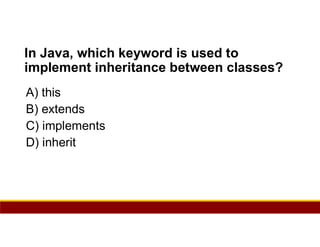











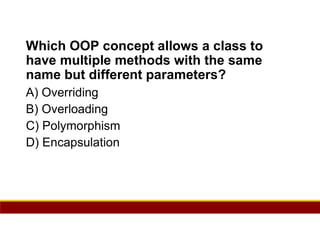
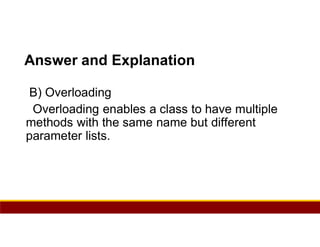






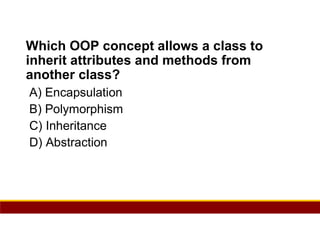








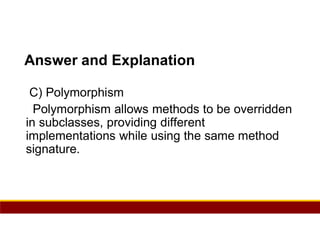

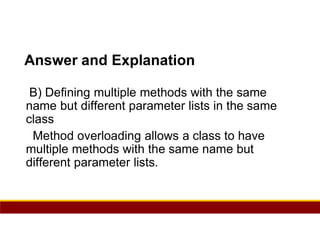



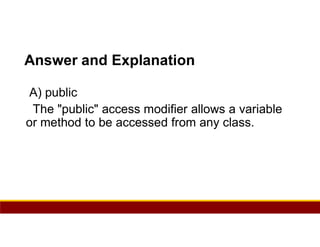










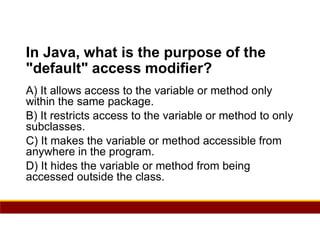








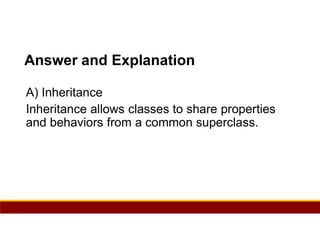





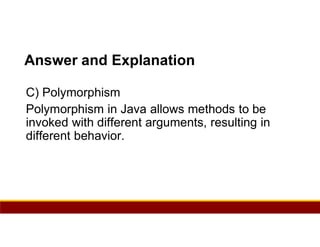


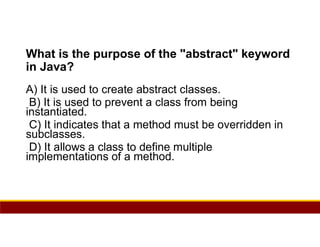


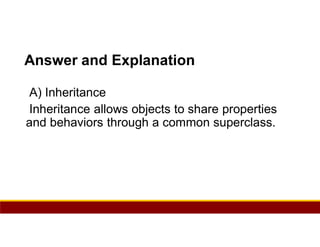


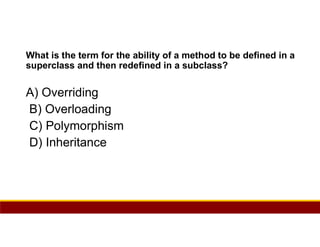
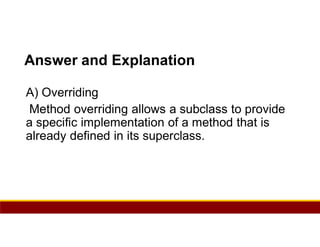





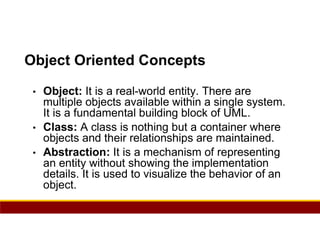



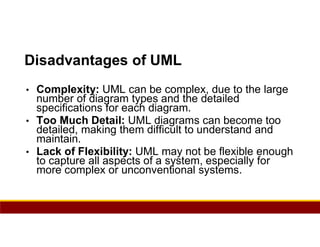
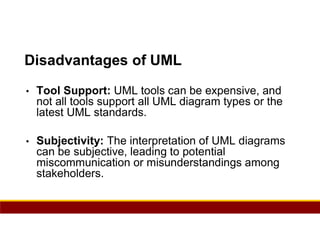


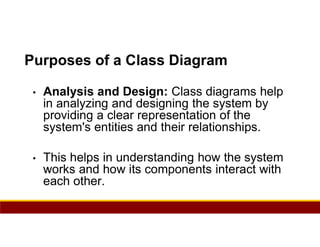
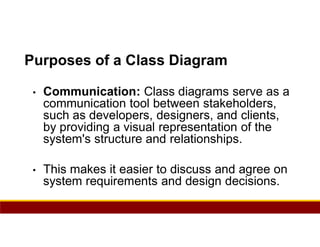



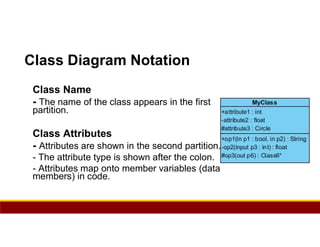
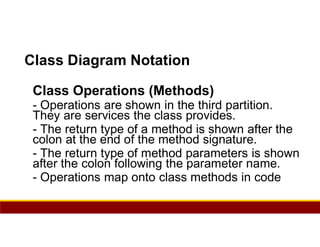
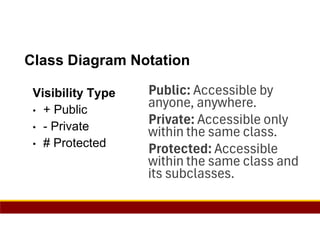
![97
Public (+)
Attribute or method
is accessible by all
other classes and
objects. Public
attributes and
methods are not
restricted to
specific classes
and can be
accessed from
anywhere.
Class Diagram
Java
+speed:int
public int speed;
+cost:double
public double cost;
+text:String
public String text;
+main(args : String[]):void
public static void main(String[]
args)
+ myMethod(fname:String,
age:int):void
public static void
myMethod(String fname, int
age)
+ plusMethodInt(x:int, y:int):int
public static int
plusMethodInt(int x, int y)](https://image.slidesharecdn.com/javaoopintroduction-240422074934-9533bba1/85/Introduction-to-Java-Object-Oriented-Programming-97-320.jpg)
![98
Private (-)
Attribute or method
is accessible only
within the class in
which it is defined.
Private attributes
and methods are
not accessible from
other classes and
objects.
Class Diagram
Java
-speed:int
private int speed;
-cost:double
private double cost;
-text:String
private String text;
-main(args : String[]):void
private static void main(String[]
args)
- myMethod(fname:String,
age:int):void
private static void
myMethod(String fname, int
age)
- plusMethodInt(x:int, y:int):int
private static int
plusMethodInt(int x, int y)](https://image.slidesharecdn.com/javaoopintroduction-240422074934-9533bba1/85/Introduction-to-Java-Object-Oriented-Programming-98-320.jpg)
![99
Protected (#)
Attribute or method is
accessible within the
class in which it is
defined and by
subclasses that inherit
from that class.
Protected attributes and
methods are not
accessible by other
classes outside the
inheritance hierarchy.
Class Diagram
Java
#speed:int
public int speed;
#cost:double
public double cost;
#text:String
public String text;
#main(args : String[]):void
public static void main(String[]
args)
#myMethod(fname:String,
age:int):void
public static void
myMethod(String fname, int
age)
#plusMethodInt(x:int, y:int):int
public static int
plusMethodInt(int x, int y)](https://image.slidesharecdn.com/javaoopintroduction-240422074934-9533bba1/85/Introduction-to-Java-Object-Oriented-Programming-99-320.jpg)
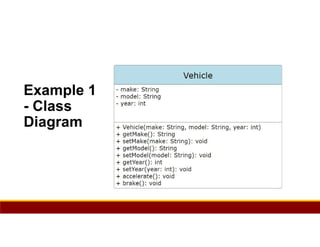

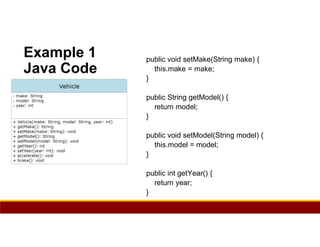

![104
Example 1
Java Code
// Main method for testing
public static void main(String[] args) {
Vehicle car = new Vehicle("Toyota", "Camry", 2022);
System.out.println("Make: " + car.getMake());
System.out.println("Model: " + car.getModel());
System.out.println("Year: " + car.getYear());
car.accelerate();
car.brake();
}
}](https://image.slidesharecdn.com/javaoopintroduction-240422074934-9533bba1/85/Introduction-to-Java-Object-Oriented-Programming-104-320.jpg)




![109
Example 2
Java Code
// Main method for testing
public static void main(String[] args) {
BankAccount account = new
BankAccount("123456789", 1000.0);
System.out.println("Account Number:
" + account.getAccountNumber());
System.out.println("Initial Balance: "
+ account.getBalance());
account.deposit(500.0);
System.out.println("Current Balance
after deposit: " + account.getBalance());](https://image.slidesharecdn.com/javaoopintroduction-240422074934-9533bba1/85/Introduction-to-Java-Object-Oriented-Programming-109-320.jpg)
